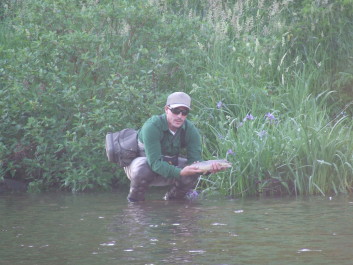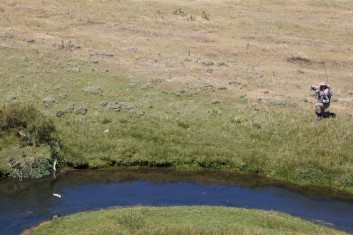Being stealthy doesn’t mean you need to go Ninja but it should be, at the very least, in your thoughts when you approach any angling situation. Think of it like this, hunters don’t simply step into the woods and expect to find game. They take precautions from the onset to conceal their presence and allow them to get closer to their quarry without alerting it prematurely. Everything from what they wear in terms of camouflage or scent covering agents, to how they walk will effect the outcome and fly anglers should take a similar approach.
Here are some tips to improve your stealth and increase your success.
1/ Wear clothing that is at least dull in colour or doesn’t contrast with your background. Light browns and olives would be my choice but try to avoid bright, contrasting colours.

Dull, neutral colours will always prevail.
Although we are uncertain as to how fish perceive colours, we know that they do see in colour so wearing bright, unnatural colours like orange, red or bright yellow would appear as a stark contrast against the trouts background. Any attention that you draw to your presence is not going to help.
2/ Approach from a downstream direction. If you approach from downstream, you have several advantages. Sound will be dampened as it won’t carry as well upstream through a current. Sediment kicked up from wading won’t be deposited through the area that you plan to fish and will help to maintain their (the fish’s) comfort level. If you approach your target from upstream, the sudden impact of a cloud of debris from the substrate can and likely will put the fish on alarm.
3/ Cleated wading boots. I always have two pairs of wading boots on the go; one with cleats and the one without. I use the uncleated boots for most of my trout fishing as it tends to be in closer quarters and I can’t help but feel that the noise created by cleats affects the fish. Sound carries approximately five times faster in water and although a trout’s environment is a noisy place, that unnatural clicking, ticking and scraping of carbide cleats against rocks has to be alarming. Cleats are unquestionably helpful and many of us have become dependent on them but if you can get away without them in familiar water, try it.
4/ Stay low, slow and deliberate. When you can, keep low on the water and wade slowly. The conditions will dictate how slow you should go but trying to get into position too quickly will likely alert the trout of your presence. The slower the run, the farther your wake will travel and disturb the surface so the slower and more deliberately you move into position, the better off you’ll be.

Note how far back from the bank the angler is. Approaching closer than this runs the risk of the trout seeing or hearing you.
Stalking a rising trout under these conditions is one of the toughest things you can do, so application of the previous three points will be paramount. Stalk from downstream and move up towards your fish, walk as slowly as you can and be careful of how much noise you create.
5/ Avoid false casting. The staccato flick of a fly line with the sun in the right spot can be a real attention grabber but not in a good way. If you have to false cast, do it beyond the range of your target where possible.
6/ Be patient and formulate a plan. If it means hauling out and taking a walk through the woods or on the bank to put yourself in a better position, do that rather than walk through the water.
7/ Only wade in when you need to. Just because you are wearing waders, doesn’t mean that you need to get in the water. In fact, you will always be better off out of the river when you can than even going in ankle deep, so where possible, stay dry.
Finally, keep this in mind; You are in the fishes environment and he is constantly vigilant. Anything that you do to disturb his natural way of doing things will likely put him off. They are no different than inadvertently jumping a deer or rabbit. Every move that he makes after being spooked is designed to save his life and they are very good at it. Once disturbed, they will often only resume feeding when they feel safe and we as angler/hunters need to recognize that.
